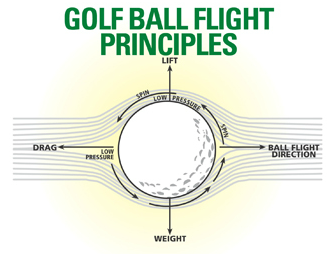The Golf Ball
|
Ball in flight
As the golf ball is in flight, there are a few net forces acting on the golf ball that should be talked about (shown in Figure 1): - After the impact of the golf club on the golf ball our golf ball takes flight; therefore,the ball will have an initial velocity, force of the golf ball in a certain vector. - The drag, as we learned in class, slows down objects in flight, so we would have to include drag on the golf ball in the opposite direction of the direction of flight. - The force of gravity Fg=mg - The lift on the golf ball is due to the launch angle with an initial velocity, spin on the golf ball, and low pressure on tope of the golf ball, and eventually turning into high pressure underneath the golf ball. |
Golf Ball Dimples
Golf balls were first engineered as smooth and round which were also known as featherie golf balls . They wouldn't travel as far due to the wake from the drag of the golf ball. They also didn't have much spin, which is ideal for when you need your ball to spin back on the greens. The wake was thick and engineers figured out that by including dimples onto a golf ball, the wake could become thinner. In 1905 William Taylor patented the design of a dimpled golf ball. This caused the drag to lessen and enabled the golf ball to soar beyond the typical smooth golf ball. |

